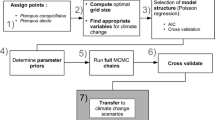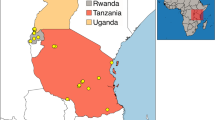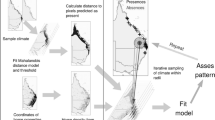Abstract
Infectious diseases are transmitted when susceptible hosts are exposed to pathogen particles that can replicate within them. Among factors that limit transmission, the environment is particularly important for indirectly transmitted parasites. To try and assess a pathogens’ ability to be transmitted through the environment and mitigate risk, we need to quantify its decay where transmission occurs in space such as the microclimate harbouring the pathogen. Hendra virus, a Henipavirus from Australian Pteropid bats, spills-over to horses and humans, causing high mortality. While a vaccine is available, its limited uptake has reduced opportunities for adequate risk management to humans, hence the need to develop synergistic preventive measures, like disrupting its transmission pathways. Transmission likely occurs shortly after virus excretion in paddocks; however, no survival estimates to date have used real environmental conditions. Here, we recorded microclimate conditions and fitted models that predict temperatures and potential evaporation, which we used to simulate virus survival with a temperature-survival model and modification based on evaporation. Predicted survival was lower than previously estimated and likely to be even lower according to potential evaporation. Our results indicate that transmission should occur shortly after the virus is excreted, in a relatively direct way. When potential evaporation is low, and survival is more similar to temperature dependent estimates, transmission might be indirect because the virus can wait several hours until contact is made. We recommend restricting horses’ access to trees during night time and reducing grass under trees to reduce virus survival.





Similar content being viewed by others
References
Ewald PW (1987) Transmission modes and evolution of parasitism. New York Acad Sci 503:295–306
Sultan B, Labadi K, Guégan J-F, Janicot S (2005) Climate drives the meningitis epidemics onset in West Africa. PLoS Med. 2:e6. doi:10.1371/journal.pmed.0020006
Shaman J, Pitzer VE, Viboud C, et al. (2010) Absolute humidity and the seasonal onset of influenza in the continental United States. PLoS Biol. 8:e1000316. doi:10.1371/journal.pbio.1000316
Walther BA, Ewald PW (2004) Pathogen survival in the external environment and the evolution of virulence. Biol. Rev. 79:849–869. doi:10.1017/S1464793104006475
McCallum H, Barlow N, Hone J (2001) How should pathogen transmission be modelled? Trends Ecol. Evol. 16:295–300
Chen J, Saunders SC, Crow TR, et al. (1996) Microclimate in forest ecosystem and landscape ecology: variations in local climate can be used to monitor and compare the effects of different management regimes. Bioscience 49
Kearney MR, Isaac AP, Porter WP (2014) Microclim: global estimates of hourly microclimate based on long-term monthly climate averages. Sci Data 1:1–9. doi:10.1038/sdata.2014.6
Murray K, Rogers R, Selvey LA, et al. (1995) A novel Morbillivirus pneumonia of horses and its transmission to humans. Emerg. Infect. Dis. 1:31–33
Smith C, Skelly C, Kung N, et al. (2014) Flying-fox species density—a spatial risk factor for hendra virus infection in horses in eastern Australia. PLoS One 9:e99965. doi:10.1371/journal.pone.0099965
Edson D, Field H, McMichael L, et al. (2015) Routes of hendra virus excretion in naturally-infected flying-foxes: implications for viral transmission and spillover risk. PLoS One 10:e0140670. doi:10.1371/journal.pone.0140670
Martin G, Plowright R, Chen C, et al. (2015) Hendra virus survival does not explain spillover patterns and implicates relatively direct transmission routes from flying foxes to horses. J Gen Virol vir.0.000073-. doi: 10.1099/vir.0.000073
Fogarty R, Halpin K, Hyatt AD, et al. (2008) Henipavirus susceptibility to environmental variables. Virus Res. 132:140–144. doi:10.1016/j.virusres.2007.11.010
Field HE, de Jong C, Melville D, et al. (2011) Hendra virus infection dynamics in Australian fruit bats. PLoS One 6:e28678. doi:10.1371/journal.pone.0028678
Scanlan JC, Kung N, Selleck P, Field H (2014) Survival of hendra virus in the environment: Modelling the effect of temperature. EcoHealth. doi:10.1007/s10393-014-0920-4
van Boekel MJS (2002) On the use of the Weibull model to describe thermal inactivation of microbial vegetative cells. Int. J. Food Microbiol. 74:139–159
Plummer M (2003) JAGS: a program for analysis of Bayesian graphical models using Gibbs sampling.
Frazer GW, Canham CD, Sallaway P, Marinakis D (1999) Gap Light analyzer Version 2.0
R Core Team (2016) R: a language and environment for statistical computing
Spiegelhalter DJ, Best NG, Carlin BP, van der Linde A (2002) Bayesian measures of model complexity and fit. J R Soc Stat 64:583–639
Myatt TA, Kaufman MH, Allen JG, et al. (2010) Modeling the airborne survival of influenza virus in a residential setting: the impacts of home humidification. Environ. Health 9:55. doi:10.1186/1476-069X-9-55
Zhao Y, Aarnink AJ, Dijkman R, et al. (2012) Effects of temperature, relative humidity, absolute humidity, and evaporation potential on survival of airborne Gumboro vaccine virus. Appl. Environ. Microbiol. 78:1048–1054. doi:10.1128/AEM.06477-11
Plowright RK, Eby P, Hudson PJ, et al. (2015) Ecological dynamics of emerging bat virus spillover. Proc. B. 282
Shaman J, Kohn M (2009) Absolute humidity modulates influenza survival, transmission, and seasonality. Proc. Natl. Acad. Sci. U. S. A. 106:3243–3248. doi:10.1073/pnas.0806852106
McDevitt J, Rudnick S, First M, Spengler J (2010) Role of absolute humidity in the inactivation of influenza viruses on stainless steel surfaces at elevated temperatures. Appl. Environ. Microbiol. 76:3943–3947. doi:10.1128/AEM.02674-09
Chang JCH, Ossoff SF, Lobe DC, et al. (1985) UV inactivation of pathogenic and indicator microorganisms. Appl. Environ. Microbiol. 49:1361–1365
Kramer A, Schwebke I, Kampf G (2006) How long do nosocomial pathogens persist on inanimate surfaces? A systematic review. BMC Infect. Dis. 6:130. doi:10.1186/1471-2334-6-130
Giles JR, Plowright RK, Eby P, et al. (2016) Models of eucalypt phenology predict bat population flux. Ecol Evol:1–16. doi:10.1002/ece3.2382
Martin GA, Yanez-Arenas C, Roberts BJ, et al. (2016) Climatic suitability influences species specific abundance patterns of Australian flying foxes and risk of hendra virus spillover. One Heal. doi:10.1016/j.onehlt.2016.07.004
Morecroft MD, Taylor ME, Oliver HR (1998) Air and soil microclimates of deciduous woodland compared to an open site. Agric. For. Meteorol. 90:141–156. doi:10.1016/S0168-1923(97)00070-1
Peleg M, Normand MD, Corradini MG (2005) Generating microbial survival curves during thermal processing in real time. J. Appl. Microbiol. 98:406–417. doi:10.1111/j.1365-2672.2004.02487.x
Scanlan JC, Kung NY, Selleck PW, Field HE (2015) The effect of environmental temperature on hendra virus survival. EcoHealth 12:10393. doi:10.1007/s10393-015-1044-1
Acknowledgements
The College of Public Health, Medical and Veterinary Sciences, James Cook University was contracted by the Rural Industries Research and Development Corporation to undertake this research project. This research was funded by the Commonwealth of Australia, the State of New South Wales and the State of Queensland under the National Hendra Virus Research Program. We would like to thank BVSc Bruce Pott for arranging contact with private horse owners to undertake this study, and Drs. Deborah Middleton and Paul Selleck for granting access to the HeV survival data.
Author information
Authors and Affiliations
Corresponding author
Electronic supplementary material
ESM 1
(PDF 3728 kb)
Rights and permissions
About this article
Cite this article
Martin, G., Webb, R.J., Chen, C. et al. Microclimates Might Limit Indirect Spillover of the Bat Borne Zoonotic Hendra Virus. Microb Ecol 74, 106–115 (2017). https://doi.org/10.1007/s00248-017-0934-x
Received:
Accepted:
Published:
Issue Date:
DOI: https://doi.org/10.1007/s00248-017-0934-x




